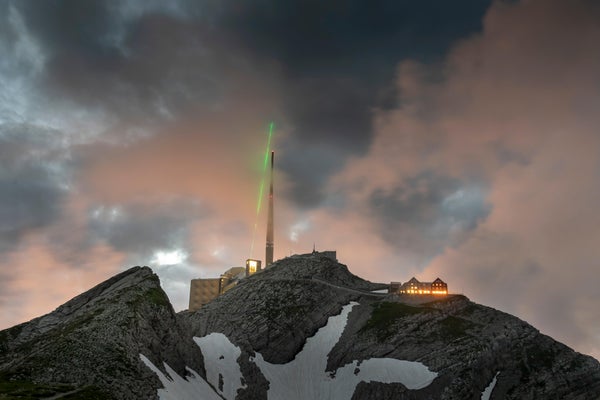Lightning strikes about 40 million times in the U.S. every year. This natural phenomenon is terrifyingly random, and we rely mainly on lightning rods—a nearly 300-year-old technology—to deal with it. But researchers are exploring a more 21st-century solution: laser beams.
Pioneered by Benjamin Franklin, the lightning rod works well to defend a building. But it has limited ability to protect larger swaths of land or sprawling facilities such as wind farms, airports and rocket launch pads. So, for a study in Nature Photonics, a team of scientists tested a high-powered laser to guide lightning strikes atop a mountain in Switzerland. This “laser lightning rod” technique could one day deflect strikes from important large-scale infrastructure, the research team says.
“What they've done is very impressive,” says Jerry Moloney, an optical scientist at the University of Arizona, who was an early pioneer of this laser application but was not involved in the study. It's “a very, very sophisticated setup.”
On supporting science journalism
If you're enjoying this article, consider supporting our award-winning journalism by subscribing. By purchasing a subscription you are helping to ensure the future of impactful stories about the discoveries and ideas shaping our world today.
Lightning occurs when friction among water droplets and ice crystals creates a static electrical charge within clouds, usually during storms. This electricity builds and eventually discharges, propelling giant sparks either upward or downward along the path of least resistance between the cloud and the ground. Regular lightning rods are made of conductive metal; they provide a preferential point for the lightning to strike and then safely channel the charge around a building and into the ground. But metal is not the only way to lure lightning away from vulnerable targets.
In the new experiment, a high-powered laser turns a column of air into an electrical conductor. When the laser fires, it separates electrons from air molecules in the beam's path, creating charged particles in a process called ionization. This transforms the air, which is typically insulating, into an attractive point for the lightning to hit—effectively creating a towering, temporary and controllable lightning rod in the sky above the area to be protected. Scientists have dreamed of building laser lightning rods for decades, but previous experiments largely failed. Older lasers could pulse only around 10 times per second, too slow to keep an air column ionized, explains Aurélien Houard, a physicist at the École Polytechnique in France and lead author of the study. The laser used in the study can fire 1,000 times per second, with each pulse lasting one trillionth of a second.
“You can burn stone if you want with this laser,” Houard says. It consumes about 10 kilowatts: roughly the power required to operate a commercial oven or seven domestic space heaters, adds the paper's senior author Jean-Pierre Wolf, a physicist at the University of Geneva.*
The researchers tested their laser's lightning-drawing ability atop Säntis, a prominent peak in the Swiss Alps chosen because lightning often hits a telecommunication tower at its summit. There, during the summer of 2021, the team recorded preliminary results while observing 16 lightning strikes, four of which occurred while the laser was powered on. And in all four cases, sensors—either a high-speed camera or a high-frequency electromagnetic wave detector—captured the lightning following the beam's path. The authors hope to fine-tune the technique with more data from future studies.
“The next step will be closer to the real-world applications,” Wolf says, “basically redoing this experiment, say, close to a launch pad or close to an airport.
Lightning strikes at airports are an “ongoing issue,” and they not only delay flights but also can injure or kill employees and travelers, says Irene Miller, an aviation researcher at Southern Illinois University, who was not involved in the study. Most airports currently rely on early-warning systems to prevent planes from taxiing or landing when the risk of a strike is high.
It remains unclear how laser lightning rod technology might be adapted to this setting; even tiny lasers aimed at the sky are notoriously dangerous to pilots. During their recent mountaintop experiment, the researchers worked with aviation authorities to designate a no-fly zone around Säntis. Narrow, temporary no-fly zones and an auto-shutoff function when planes are in range could potentially address safety concerns, the study authors say.
For now, though, Benjamin Franklin's innovation will have to do.
*Editor’s Note (3/31/23): This sentence was edited after posting to correct the description of the power consumed by the laser.
